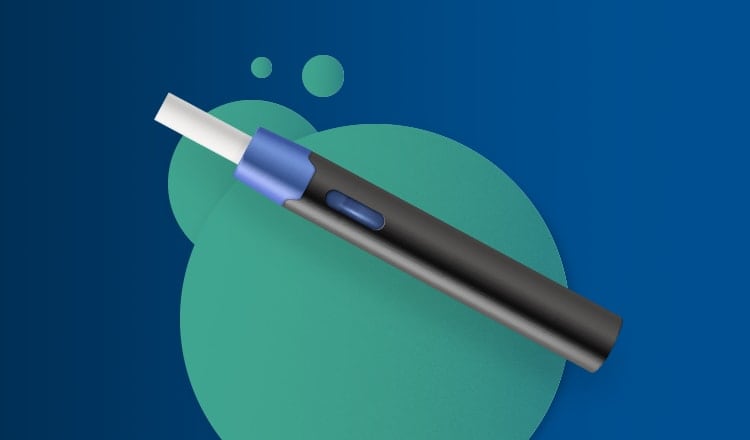/people_subpages_heated-tobacco_750x440px.jpg)
Heated tobacco products heat real tobacco instead of burning it. This is an important difference between these smoke-free products and cigarettes.
Because they don't burn the tobacco, these products are smoke-free—producing a nicotine-containing aerosol that is fundamentally different from cigarette smoke.
Importantly, these products are not risk-free and provide nicotine, which is addictive, but our science shows they are a better choice for adults than continuing to smoke cigarettes.
IQOS ILUMA
- Use induction to heat tobacco—without burning it—releasing nicotine-containing vapor
- Emits on average 95 percent lower levels of harmful chemicals compared with cigarettes 1
- Bladeless SMARTCORE INDUCTION SYSTEM™ heats tobacco from within the TEREA SMARTCORE STICKS™—heated tobacco units designed to be used only with IQOS ILUMA
- No tobacco residue and no need to clean
- Our most advanced heated tobacco device yet, thanks to the improved draw, stick-by-stick taste consistency, and its intuitive design
1 Average reductions in levels of a range of harmful chemicals (excluding nicotine) compared to the smoke of a reference cigarette (3R4F). Importantly, this does not necessarily equal a 95 percent reduction in risk, and IQOS ILUMA is not risk-free.
IQOS ILUMA PRIME
/img_pmi_smoke-free_products_devices_iluma_prime.jpg)
PMI’s latest ILUMA device provides two consecutive uses without recharging the holder.
IQOS ILUMA
/img_pmi_smoke-free_products_devices_iluma.jpg)
Our original ILUMA product provides two consecutive uses without any holder recharging.
IQOS ILUMA ONE
/img_pmi_smoke-free_products_devices_iluma_one.jpg)
Practical, all-in-one design delivers 20 consecutive uses per charge.
IQOS ORIGINALS
- Time-tested HEATCONTROL™ TECHNOLOGY heats tobacco with a blade from inside the tobacco stick
- Heats tobacco without burning it
- No fire, ash, or smoke
- Nicotine-containing vapor emits on average 95 percent lower levels of harmful chemicals compared with cigarettes 2
- IQOS ORIGINALS uses specially designed HEETS tobacco sticks made of high-quality tobacco blend for cigarette-like satisfaction
2 Average reductions in levels of a broad range of harmful chemicals (excluding nicotine) compared to the smoke of a reference cigarette (3R4F). It does not necessarily equal a 95 percent reduction in risk. This product is not risk-free.
IQOS ORIGINALS DUO
/img_pmi_smoke-free_products_devices_iqos_duo.jpg)
Device provides two consecutive uses.
IQOS ORIGINALS ONE
/img_pmi_smoke-free_products_devices_iqos_one.jpg)
Practical, all-in-one design delivers three consecutive uses.
BONDS BY IQOS
- The latest addition to PMI’s smoke-free product portfolio
- More affordable product, using bladeless-heating technology
- Resistive external heating, with no blade, via the ROUNDHEAT TOBACCO SYSTEM™
- Heats tobacco without burning it, producing no fire, ash, or smoke
- Emits on average 95 percent lower levels of harmful chemicals compared to cigarettes 3
- Designed to be used only with BLENDS tobacco sticks to deliver a variety of tobacco tastes
3 “95 percent less” represents the average reductions in levels of a range of harmful chemicals (excluding nicotine) compared to the smoke of a reference cigarette. It does not necessarily equal a 95 percent reduction in risk. BONDS BY IQOS is not risk-free.
/img_pmi_smoke-free_products_devices_bonds.jpg)
Compact, easy-to-use, and affordable bladeless-heating product.
lil SOLID Ez, introduced by IQOS*
- All-in-one tobacco heating device introduced by IQOS that heats tobacco from the inside with a ceramic pin for a consistent tobacco experience
- Generates nicotine-containing aerosol through resistive external heating
- No fire, ash, or smoke
- Emits on average around 95 percent lower levels of harmful chemicals compared to cigarettes 4
- Allows three consecutive uses
- Full charge can enable the use of approximately 25 Fiit tobacco sticks, designed to be used only with Iil SOLID Ez
4 Average reductions in levels of a range of harmful chemicals (excluding nicotine) compared to the smoke of a reference cigarette. It does not necessarily equal a 95 percent reduction in risk. lil SOLID Ez is not risk-free.
/heated-tobacco-products/lil_solid-ez-mint-png.png)
Evenly heats tobacco, providing three consecutive uses.
lil HYBRID, introduced by IQOS*
- HYBRID technology heats tobacco and liquid all at once for a combined experience
- Emits, on average, around 95 percent lower levels of harmful chemicals compared to cigarettes 5
- Heated tobacco sticks MiiX and liquid cartridges give a rich taste experience with enhanced aerosol
- No fire, ash, or smoke—regular cleaning is not required
- Simple to use smoke-free product with the digital screen that features key information at a glance: puff count, battery, and liquid levels
5 Average reductions in levels of a range of harmful chemicals (excluding nicotine) compared to the smoke of a reference cigarette. lil HYBRID is not risk-free.
/img_pmi_smoke-free_products_devices_lil_hybrid.jpg)
Heated tobacco and liquid flavors combined in a single device.
*As per the global collaboration agreement between PMI & KT&G, first announced in January 2020—PMI will distribute, outside of Korea, a variety of heated tobacco systems from the KT&G portfolio. After three years of successful collaboration, PMI announced arrangements to extend and deepen the collaboration with KT&G in January 2023. The agreements provide long-term exclusive rights for PMI to commercialize KT&G’s innovative smoke-free products outside of South Korea. The trademark license agreement covers fifteen years, to January 29, 2038, with performance-review cycles and associated commitments, based on volume, to be confirmed for each three-year period, to allow flexibility for evolving market conditions.

/heated-tobacco-banner_jan2024.jpg)


